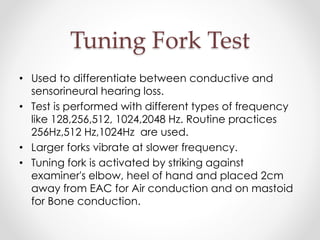

However, if after being given the instructions again, their responses don’t improve, it’s advised to use objective tests which don’t require patient participation in order to further validate the Stenger results. It’s always recommended to repeat instructions to the patient. If, once this is obtained, and a gap of 20 dB or more is present between ears, a speech Stenger test can be performed, just like the tone Stenger testing. Speech Recognition Threshold (SRT) tests use spondaic words to obtain thresholds for speech reception. Stenger testing can also be performed on some audiometers with speech material. Remember, the patient should ALWAYS respond since they will always be hearing the tone in the better ear. If the patient stops responding, that intensity should be noted as the MCIL If the patient responds, continue to increase the intensity of the tone in the poorer ear by 5-10 dB.In the poorer ear, set the intensity level at 0 dB.In the better ear, set the intensity level 10 dB above the threshold.To obtain MCIL, continue using the Stenger test: According to Martin & Clark (2019), responses may be within 20 dB of the patient’s actual threshold. The minimum contralateral interference level (MCIL) is the lowest level at which the Stenger effect can be obtained. At this time, more testing can be done to obtain more information in regards to the where the hearing threshold is in the poorer ear. When a positive Stenger occurs, it is an indication of a nonorganic hearing loss. This means that the patient is hearing the sound in the poorer ear and is able to tell that it is softer than the previous “threshold” and therefore they are not responding since they perceive it to be softer. This is an indication that the recorded response in the poorer ear is true, and suggests that a nonorganic hearing loss is not present.įor the example above, a Stenger test needs to be done at all other frequencies in which a 20 dB difference or greater is seen in order to ensure accurate responses at all frequencies.Ī positive Stenger occurs when the patient does not raise their hand when the tone is presented simultaneously to both ears. This means that the patient is hearing the sound in the better ear and is responding correctly. The tone will be present to both ears.Ī negative Stenger occurs if the patient raises their hand when the tone is presented simultaneously to both ears. At 500 Hz the right ear will be decreased to 60 dB Decrease the tone in the poorer ear by 10 dB from the original threshold. E.g.E.g.500 Hz in the left ear will be increased to 30 dB Increase the tone in the better ear by 10 dB from threshold obtained.By choosing the Stenger test, both ears will now have the same tone being presented to both ears. Most modern audiometers will either have a Stenger button or a drop-down menu on the computer /audiometer screen where Stenger testing can be selected. The procedure may differ depending on the audiometer that is being used. Example of Asymmetrical hearing loss in the right ear.įor this patient, there is a 20 dB or more difference from 250-8000 Hz, so a Stenger test is needed at every frequency. Stenger testing can be done for tones when there is a 20 dB gap or more between ears at any frequency as shown in Figure 1 below:įigure 1. Stenger testing is usually performed on an audiometer but it can also be done with tuning forks. < This basically means that if the same sound (tone or speech) is presented simultaneously to each ear, the patient is unable to tell that the sound is being heard by both ears. The Stenger test is based on the principle, “when two tones of the same frequency are introduced simultaneously into both ears, only the louder tone is perceived” 2. One of the best behavioural tools for determining whether a unilateral hearing loss is nonorganic is the Stenger test.

Also known as a functional hearing loss and pseudohypacusis, this type of hearing loss is a decrease in hearing that is unexplained by anatomic or physiologic abnormalities (or both) 1. There will be a time in any hearing professionals’ career when a patient is not responding at threshold and presents a nonorganic hearing loss.


 0 kommentar(er)
0 kommentar(er)
